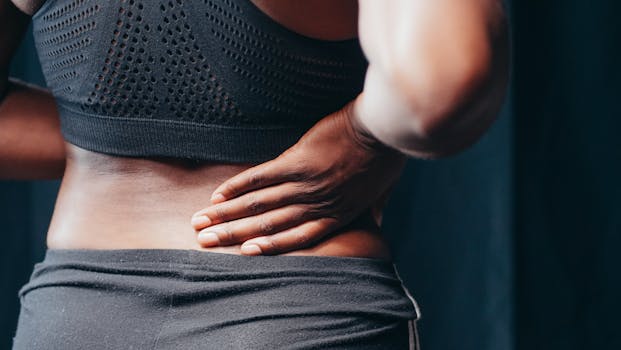Contact Us 720-964-1335 or 901-675-6125
Back Pain in Women Over 40: What Does It Mean …Holistically?

Why Back Pain Becomes More Common After 40
If you’ve found yourself waking up with stiffness, ending the workday with an aching lower back, or struggling to get comfortable during a workout, you’re not alone. Back pain is one of the most common health complaints among women over 40, and it can range from mild, nagging discomfort to pain that disrupts daily life… and it often feels like it comes out of nowhere.
As we age, natural changes in the spine, joints, and muscles can increase vulnerability. Add hormonal shifts, lifestyle habits, and the demands of balancing work, home, and self-care, and it’s easy to see why many women face back pain at this stage of life.
But here’s the good news: while back pain becomes more common after 40, it doesn’t have to be your new normal. By understanding the reasons behind it and learning strategies for prevention and relief, you can protect your spine, improve mobility, and keep doing the activities you love.
Common Causes of Back Pain in Women Over 40
While back pain can happen at any age, certain factors become more relevant after 40:
- Degenerative changes – The discs between your vertebrae lose water content and elasticity, making them more prone to bulging or herniation.
- Hormonal shifts – Perimenopause and menopause can contribute to joint stiffness, muscle loss, and changes in pain perception.
- Poor posture – Years of desk work, phone scrolling, or repetitive movements can create imbalances in muscle strength and flexibility.
- Sedentary lifestyle – Lack of regular movement weakens core muscles, leaving your spine less supported.
- Weight gain – Carrying extra weight, especially around the midsection, places added stress on the spine.
- Stress & cortisol imbalance – Chronic stress can cause tension in the shoulders and lower back while increasing inflammation in the body.
Signs Your Back Pain Needs Medical Attention
Most back pain improves with self-care and lifestyle adjustments, but sometimes it’s a sign of something more serious. Call your provider if you experience:
- Pain that radiates into the legs or feet
- Numbness, tingling, or weakness in the lower body
- Difficulty controlling bladder or bowel function
- Sudden, severe pain after injury
- Unexplained weight loss with back pain
Holistic Approaches to Relieve and Prevent Back Pain
At Ample Health & Wellness, I encourage clients to approach back pain the same way we approach weight loss …by addressing root causes, building healthy habits, and supporting the whole body. Here’s how the FRESH Framework applies to back health:
F – Food Freedom
Nutrition plays a big role in reducing inflammation, supporting bone health, and maintaining muscle mass.
- Increase anti-inflammatory foods like salmon, leafy greens, berries, turmeric, and olive oil.
- Limit processed foods and excess sugar, which can worsen inflammation.
- Get enough calcium and vitamin D from food or supplements to support bone strength.
R – Rewire the Mindset
Chronic pain can create a fear of movement, but gentle activity often speeds recovery.
- Practice body awareness to identify movements or postures that trigger pain.
- Use mindfulness techniques to manage stress, which can worsen muscle tension.
E – Elevate with Habits
Daily habits can either protect your back or contribute to pain.
- Incorporate core-strengthening exercises like planks, bird dogs, and pelvic tilts.
- Stretch hamstrings, hip flexors, and lower back daily to improve mobility.
- Take movement breaks every 30–60 minutes if you sit for long periods.
S – Simplify Your Environment
Small ergonomic adjustments can make a big difference:
- Choose a chair with lumbar support.
- Adjust your computer monitor to eye level.
- Use supportive footwear to reduce strain on the spine (especially if standing long hours).
H – Honor Whole Health
Back pain isn’t just physical; it’s influenced by sleep, stress, and overall wellness or lifestyle.
- Aim for 7–9 hours of quality sleep to allow tissues to repair.
- Practice deep breathing or meditation to reduce tension.
- Stay hydrated to support joint and muscle health.
Natural Relief Strategies You Can Try at Home
If you’re experiencing mild to moderate back pain, these strategies may help:
- Heat therapy – Apply a warm compress or heating pad for 15–20 minutes to relax tight muscles.
- Cold therapy – Use ice packs for acute pain or swelling.
- Gentle yoga or stretching – Focus on poses like cat-cow, child’s pose, and spinal twists.
- Low-impact exercise – Walking, swimming, and cycling can keep you active without stressing the spine.
- Foam rolling or massage – Helps relieve tension in tight muscles.
When Exercise Helps …and When It Hurts
Exercise or movement is one of the most effective tools for preventing and managing back pain, but it’s important to choose the right type and intensity.
- Helps: Core work, low-impact cardio, stretching, resistance training.
- Hurts: High-impact jumping, heavy lifting with poor form, or twisting under load.
Working with a professional, whether it’s a physical therapist, personal trainer, or holistic weight loss coach, can help you create a safe, personalized plan that builds strength while protecting your spine.
Prevention Is Just as Important as Relief
One of the best things you can do for your back is prevent pain before it starts. Simple daily choices can reduce stress on your spine and protect long-term mobility:
- Carry bags evenly instead of always on one shoulder.
- Sleep on a supportive mattress and avoid slumping into soft couches for long periods.
- Stay active to avoid stiffness (motion is medicine).
- Keep your weight in a healthy range to reduce spinal stress.
How Ample Health & Wellness Can Support You
If back pain is interfering with your weight loss goals, energy, or quality of life, you don’t have to face it alone. I help women over 40 build strong, pain-resistant bodies through a combination of:
- Anti-inflammatory nutrition coaching
- Strength and mobility programs tailored to your needs
- Stress management and recovery strategies
- Accountability and support every step of the way
Together, we can reduce pain, improve posture, and keep you moving with confidence.
Final Thoughts
Back pain after 40 doesn’t have to be your “new normal.” By addressing the root causes, improving daily habits, and giving your body the right support, you can reduce pain, improve mobility, and continue enjoying the activities you love.
If you’re ready to take control of your back health while also focusing on weight loss and whole-body wellness, I’d love to help you create a plan that works for you.
🔗 Learn more at AmpleHealthAndWellness.com or in our book The Weight Is Over

References:
- Qaseem, A., et al. (2017). Noninvasive treatments for acute, subacute, and chronic low back pain: A clinical practice guideline. Annals of Internal Medicine, 166(7), 514–530. https://doi.org/10.7326/M16-2367
- Wu, A., et al. (2020). Global low back pain prevalence and years lived with disability from 1990 to 2017. Annals of Translational Medicine, 8(6), 299. https://doi.org/10.21037/atm.2020.02.175
- Maher, C., et al. (2019). Low back pain. The Lancet, 393(10137), 2356–2367. https://doi.org/10.1016/S0140-6736(19)30480-X
